Here are the images for you again from last week’s blog. This week we will explore the relationship between over-striding and cadence. Below each photo I have written the athletes cadence in steps per minute. Each athlete was asked to run at their current 5km pace.

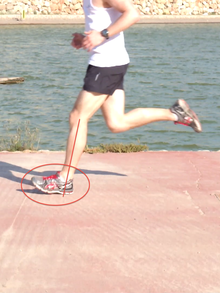
Cadence: 188 Cadence: 184
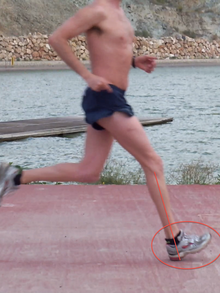
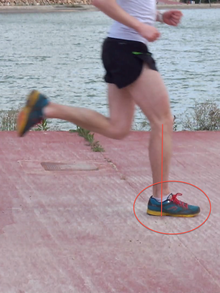
Cadence: 194 Cadence: 196
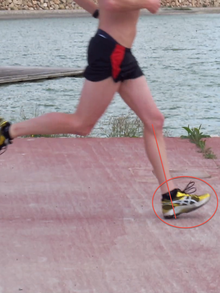

Cadence: 180 Cadence: 196
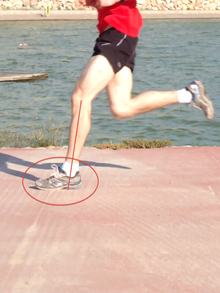

Cadence: 177 Cadence: 180
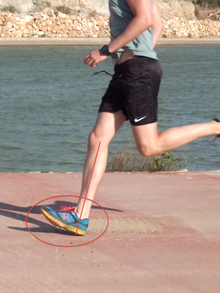
Cadence: 171
Firstly, you can see there is a significant variation in cadence within a small group all running at 5km pace. Whether or not they were running at 5km pace is difficult to say as the trials were run over a much shorter distance. It does beg the question that if there is so much individual variation in cadence should we really expect everyone to run most efficiently at a cadence of 180 steps per minute? I don’t think it is that simple.
Secondly, over-striding is often said to be a problem in athletes who have long slow strides. You can see however that some of the athletes above, with a cadence of 180 or more, still seem to be over-striding. While experimenting with increasing cadence may benefit some of the athletes who appear to be over-striding, others may need a different approach.
What strategies might be used then to reduce the tendency to over-stride? Video analysis and giving feedback to the athlete using images like this I am sure will prove to be very useful. We can use specific running drills to encourage appropriate placement of the foot without ‘reaching’ for the landing. Coach Mick Cairns describes some cues and drills in his comment here from an earlier blog. Performing ‘strides’ before and after a main set can be very effective. Strides are short efforts of 60-100m focussing on maximising efficiency through making small changes to your technique e.g. keeping the body slightly more upright rather than leaning forwards. It is very difficult to over-stride while running up a hill. A gentle incline that flattens out at the top would be ideal for working on this aspect of technique. The athlete would run up the hill and then try to maintain the same stride characteristics, in terms of placement of the foot, when they reach the flat section.
The last thing I want to do is make people paranoid about the way they run. The most important thing is that you are running injury free, enjoying your running and happy with your performance. If you are all of the above then keep on running because contrary to popular belief it is actually very good for you. I can’t wait to see this new film, to be released this summer, featuring some of the world’s greatest ever distance runners! See you in the weekend, Tim (LFTC Coach).
Another amazing video clip Tim! Do you have any advice about changing to running flats from more heavily padded trainers?
Thanks,
Hannah
Also food for thought, this article is quite interesting for those of you going long.
Matt Phillips @ Stride UK talks through cadence of runners at last months Brighton Marathon. Some of the sub 3.15 guys were coming in at a cadence of 200. Have a look but here are some points.
As overall race time increases, cadence tends to decrease. The two participants with a cadence of over 190spm both managed sub 3:10 race times. I wonder what the 172spm runner with a time of 3:01:09 could achieve if he managed to increase his cadence by 10%?
For runners who exhibited a high cadence but slow race time, maybe this is evidence that they need to focus more on other aspects of running fitness: strength, posture, mobility, etc.
Thus it’s important when working on cadence to also learn where to find the stride length needed for a given pace.
Echoing Tims comments earlier about not getting completely hung up on all this you can try to up your cadence a little ( 5% ), see how it feels and how you do that? Picking your legs/feet up rather than striding out for example.
Hopefully the drills that we are doing at the sessions (that you are obviously doing in your own time whilst out on your own runs) will help with both.
I am thinking next time l may have to film half way through a training session and in camouflage to get accurate running form footage!
The film looks amazing, get me some popcorn and l am all over this!
oops here is the link:
http://runnersconnect.net/running-training-articles/running-cadence-injury/
Hi Hannah. Good question. The way I see it is the ease at which you make the transition to racing flats or a more minimalist shoe will depend on two things. Firstly, your current shoe. If you run in a heavy stability trainer, the change will be more significant than if you run in a light weight neutral trainer. Secondly and probably more importantly, your running form will have a significant impact (excuse the pun!) on how easily you make the transition to a racing flat or minimalist shoe. A heavy heel striker will require a longer period to adjust than someone who is a mid foot striker who is quite light on their feet. Like all aspects of training an individualised approach is what is needed. A change in running form might be required and this should take time with specific technique work and conditioning to avoid overloading tissues resulting in injury. If you do run in a stability trainer then going from this to a neutral trainer and then finally to a racing flat will ensure you make the change gradually. Like any new shoes you need to break them in by using them initially just for walking, then shorter runs, tempo runs and finally long runs. I hope that helps. Tim (LFTC Coach)
Great stuff! Will give it a whirl…
Some thoughts on the movie clip, running and yoga.
“Transcendence”: “RUNNING AS MEDITATION”
The movie clip ends with this quote;
“If you believe in something larger than you, then you transcend yourself”.
This and another quote from this movie “when I think of God I think of myself”,
Remind me of the mantra that I have been working on with the “yoga for athletes” course. “So ham” “ham sa”. It literally translates to: “I am that, that I am.”. With every breath we are reminded that we are connected to the Universe (divinity) and each other, by the air that we share.
We often get caught up in “doing”, by remembering that we are bigger than that which we “do”, we have an opportunity to “be”. In “being”, we find our true nature. Thus we can train hard, try our best, push to our limits-and know that this is only what we do-this does not define who we are.
Also, anything that is done with integrity as its guide has value. When we act from a place of authenticity there is an effortless-ness and ease in what we do.
Gail, that reminds of a conversation I heard once between Yoda and Luke Skywalker. Are you sure you aren’t a Jedi Master as well as GB age grouper and yoga instructor?